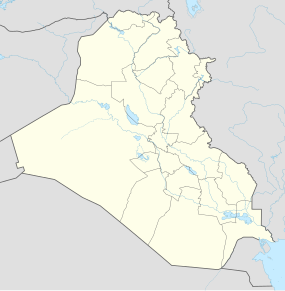Jemdet Nasr
| جمدة نصر | |
| Location | Iraq |
|---|---|
| Region | Babil Governorate |
| Coordinates | 32°43′01″N 44°46′44″E / 32.717°N 44.779°E |
| Type | tell |
| Area | 1.5 hectares (3.7 acres) (Mound A), 7.5 hectares (19 acres) (Mound B) |
| Height | 2.9 metres (9 ft 6 in) (Mound A), 3.5 metres (11 ft) (Mound B) |
| History | |
| Material | mudbrick |
| Periods | Ubaid, Uruk, Jemdet Nasr, Early Dynastic I, Parthian? |
| Site notes | |
| Excavation dates | 1926, 1928, 1988, 1989 |
| Archaeologists | S.H. Langdon, L.Ch. Watelin, R. Matthews |
Jemdet Nasr (Arabic: جمدة نصر) is a tell or settlement mound in Babil Governorate (Iraq) that is best known as the eponymous type site for the Jemdet Nasr period (3100–2900 BC). The site was first excavated in 1926 by Stephen Langdon, who found proto-cuneiform clay tablets in a large mudbrick building thought to be the ancient administrative centre of the site. A second season took place in 1928, but this season was very poorly recorded. Subsequent excavations in the 1980s under British archaeologist Roger Matthews were, among other things, undertaken to relocate the building excavated by Langdon. These excavations have shown that the site was also occupied during the Ubaid, Uruk and Early Dynastic I periods.
In 1925, the team that was excavating at Kish received reports that clay tablets and painted pottery had been found by locals at a site called Jemdet Nasr, some 26 kilometres (16 mi) northeast of Kish. The site was subsequently visited and it was decided that an excavation was necessary. The first season at Jemdet Nasr took place in 1926, directed by Stephen Langdon, Professor of Assyriology at Oxford University and director of the excavations at Kish. The excavation lasted over a month and employed between 12 and 60 workmen. Langdon was not an archaeologist, and even by the standards of his time, as exemplified by Leonard Woolley's work at Ur, his record-keeping was very poor. As a result, much information on the exact find spots of artefacts, including the tablets, was lost. A large mudbrick building was excavated in which a large collection of proto-cuneiform clay tablets was found. The finds from this season were divided between the National Museum of Iraq in Baghdad, the Ashmolean Museum in Oxford and the Field Museum in Chicago; the latter two co-sponsors of the excavations in Kish and Jemdet Nasr. A second season was organized in 1928, lasting between 13–22 March and directed by L.Ch. Watelin, the then-field director at Kish. This time, some 120 workmen were employed. Watelin kept almost no records of his excavations at the site but from the few notes that survive he seems to have been digging in the same area as Langdon.
...
Wikipedia

